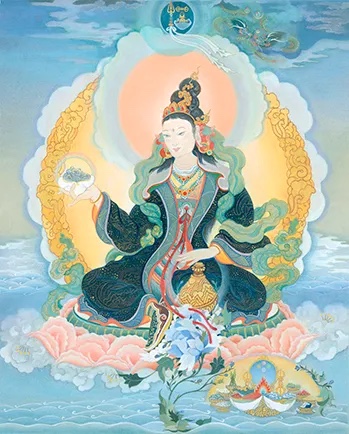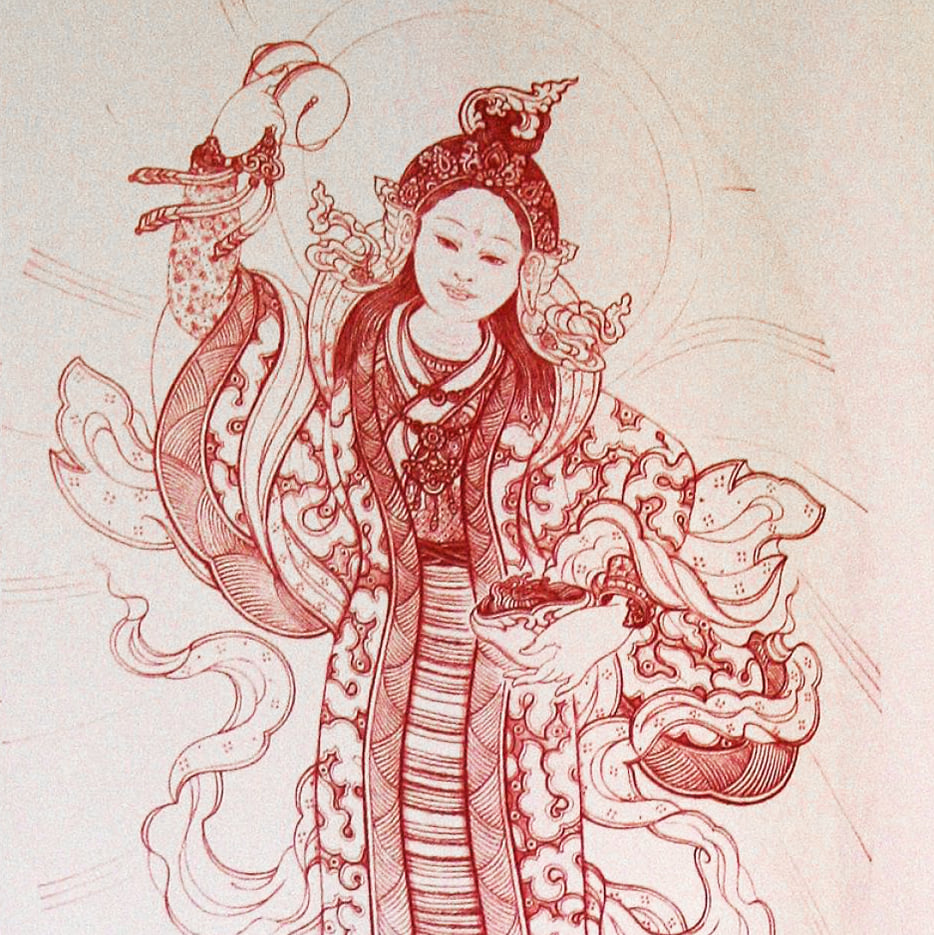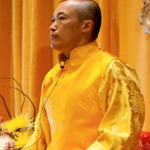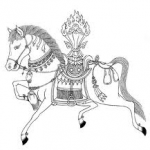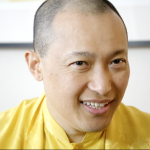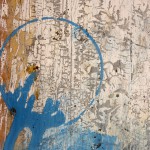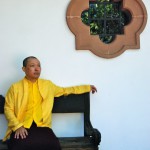Wednesday
Who Was Yeshe Tsogyal?
By Holly Gayley
Holly Gayley discusses the power of Padmasambhava’s foremost disciple and consort, Yeshe Tsogyal, and the life of one of her modern emanations.
Yeshe Tsogyal is the preeminent lady of Tibetan Buddhism. While most—if not all—of what we know about her life is highly mythologized, she is revered by Tibetans as a foremost disciple and consort of Padmasambhava, the eighth-century tantric master credited with a seminal role in establishing Buddhism in Tibet. Yeshe Tsogyal is also celebrated for transcribing Padmasambhava’s teachings and concealing them as treasures across the Tibetan and Himalayan landscape, to be revealed by successive tertöns, or “treasure revealers,” during times of strife.
In her well-known namthar, or story of “complete liberation,” which was revealed by the seventeenth-century tertön Taksham Nuden Dorje (available in English translations by Keith Dowman and the Padmakara Translation Group), Yeshe Tsogyal is portrayed as a gutsy woman striving for enlightenment. She faces various trials while practicing meditation in mountain solitudes: scorn from villagers, torment by demons, starvation, and even rape. Through these trials, she is shown transforming adversity into fuel for her practice and gaining realization. Moreover, in her namthar, one finds the striking statement by Padmasambhava that a woman with strong determination has a greater potential for attaining enlightenment than a man. In this way, Yeshe Tsogyal serves as an important example of a woman who traversed the Buddhist path.
However, if we think of Yeshe Tsogyal primarily as an ancestor who demonstrates that enlightenment is possible in female form, we grossly underestimate her significance for Tibetans. Moreover, we run into the problem (as with so many female figures in Buddhist literature) of establishing her historicity.
For Tibetans, Yeshe Tsogyal is not just a figure from the distant past; she remains an active and enduring presence. In the outer frame of her namthar, we see her portrayed as a timeless being—an emanation of Sarasvati—who took human form in Tibet for the sake of propagating the dharma. And at the end of her tale, before dissolving into space, Yeshe Tsogyal promises to continue to respond to the prayers of devotees, to appear to adepts in visions, and to continue to send forth emanations.
But her story does not end there. Over the centuries, Yeshe Tsogyal has remained accessible to ordinary Tibetans through numerous liturgies that supplicate her. In addition, her potent blessings are understood to remain in the places she practiced as well as the objects she touched (strands of hair, articles of clothing, ritual implements, etc.), considered to be relics of contact. To spiritual virtuosos, both male and female, Yeshe Tsogyal also appears in visions, posing riddles, offering encouragement, or expounding on the contents of a treasure teaching.
What’s more, Yeshe Tsogyal’s presence continues in the lives of historical women who are regarded to be her emanations. Indeed, exceptional women in the Nyingma school of Tibetan Buddhism are often identified as an emanation of Yeshe Tsogyal and sometimes referred to as “Yeshe Tsogyal in person.” Her emanations include the few female tertön known to us, such as Jomo Menmo (thirteenth century) and Sera Khandro (early twentieth century), as well as Mingyur Paldrön, the daughter and successor of the famed seventeenth-century tertön Terdak Lingpa, founder of Mindroling Monastery outside of Lhasa.
From one perspective, we could say that Yeshe Tsogyal serves as an authoritative precedent, creating a cultural space for female religious authority within the otherwise male-dominated Buddhist milieu in Tibet. From another perspective, through the women identified as her emanations, Yeshe Tsogyal continues to be an active presence, intervening in the lives of ordinary Tibetans.
To illustrate this, let me introduce a contemporary female tertön from the region of Golok in eastern Tibet: Khandro Tare Lhamo (1938–2002), an emanation of Yeshe Tsogyal who served as a beacon of hope for her local community during a devastating chapter of Tibetan history. The period leading up to and including the Cultural Revolution (1966–76) witnessed the destruction of most visible symbols of Tibetan culture: monasteries were closed, texts were burned, sacred objects were looted, monks and nuns were forced to defrock, and public religious observances were forbidden. Many lamas fled into exile or died in prison, including Khandro Tare Lhamo’s first husband and three brothers, who were incarcerated in the late 1950s.
Perhaps because she was a woman, Khandro Tare Lhamo was spared imprisonment, though I was told that she did endure beatings. On one harrowing occasion, officials placed her bare chest on a hot wood-burning stove. According to the old woman who told me this story, Khandro Tare Lhamo reflected on the far greater sufferings of beings in the hell realms, and as a result she had no burn marks afterward.
One cannot find such tales in her namthar, Spiraling Vine of Faith. Since it was published in China, most of her personal misfortunes and hardships are left out, likely due to the continued sensitivity of the “Tibet question.” For this reason, the stories told about Khandro Tare Lhamo in her namthar emphasize the miracles she performed for her local community, rather than the trials she endured. For example, during a famine in the wake of the Great Leap Forward, there is no mention of the hunger she and others must have faced; we read only of her miraculous ability to multiply a measure of rice to feed those around her. And while working as part of a crew constructing a pen for wild yaks, she is reported to have carried a stone too heavy for a group of men to lift, leaving an imprint of her hand in it.
These stories show how Khandro Tare Lhamo, as an enlightened being who took rebirth for the sake of others, embodied the paradox of being confined to her historical circumstances while seeming to transcend the laws of nature. Though miraculous in tenor—as when she reportedly stopped a rockslide threatening to overwhelm a crowd with a simple gesture of her hand—her activities were nonetheless grassroots in scale, addressing the immediate needs of her local community.
Khandro Tare Lhamo’s role in the Buddhist revival in Golok beginning in the 1980s was possible due to her identification with Yeshe Tsogyal. With the onset of China’s policy of “reform and opening,” religious observances were once again allowed, and Tibetans began an arduous process of rebuilding monasteries and recovering and reprinting precious texts. In Golok, treasure revelation played a significant role in this revival as a means to recover ancient teachings from amidst the debris. For the Nyingma, treasures are meant to be revealed during troubled times, when they promise to heal the damage to the teachings and beings, thereby heralding a new era for Buddhism and society to flourish.
As an emanation of Yeshe Tsogyal, Khandro Tare Lhamo was understood to have access to the teachings of Padmasambhava in the form of treasures, sealed in the Tibetan landscape and also in the mind stream of the tertön. Together with her second husband, Khandro Tare Lhamo revealed a twelve-volume corpus of treasure literature, including a volume dedicated to Yeshe Tsogyal and a series of female deities. From the mid-1980s onward, the couple traveled and taught together, propagating these treasures.
As these stories show, for Tibetans, Yeshe Tsogyal is more than an ancestor from the distant past or simply a role model to affirm women’s potential for enlightenment. Indeed, she remains an active presence in the lives of Tibetans–both men and women–through rituals dedicated to her and through the historical women who serve as her emanations. The well-known emanations of Yeshe Tsogyal mentioned above are only the tip of the iceberg. As time goes on, more and more stories of female adepts and spiritual teachers in Tibet are coming to light. Indeed, if present circumstances are any indication, for every female Buddhist teacher who made it into the historical record, there were at least a dozen or more on the ground. As the number of studies on exceptional Tibetan women grows, let us hope that we can consider not only issues of gender but also the impact and influence of these women on Buddhist history.
Reposted from Lion’s Roar December 1, 2007
*Judith Simmer-Brown will host Yeshe Tsogyal and the Feminine Principle through Shambhala Online beginning June 17, 2023. To Learn more and register please click here.
Entries filed under Dharma Teachings
Investigation of the Dedication – HIGHLIGHT
Taking a closer look at one of our most familiar chants, the Shambhala Dedication of Merit By Russell Rodgers Mural depicting one of the Rigden Kings By the confidence of the golden sun of the great east, May the lotus garden of the Rigden’s wisdom bloom. May the dark ignorance of ... continuePosted February 28, 2016 by CGH
Think About It; Beliefs Matter – HIGHLIGHT
A reflection on how our beliefs influence our behavior, our communities, and our ability to live in ways that reflect basic goodness. by Shastri Christine Heming Recently, as I was preparing to teach about the power of kindness, I found myself re-reading many of my most revered books, ... continuePosted February 26, 2016 by CGH
Sakyong Gives Talk at Gongter – HIGHLIGHT
Sakyong Mipham Rinpoche Addresses Western Students at the Gongter Near the end of the Gongter, Sakyong Mipham Rinpoche gave an evening talk to the Westerners and English-speaking Tibetans attending the empowerments. About two hundred people attended the event, which was followed by a blessing line where everyone ... continuePosted November 16, 2015 by CGH
Taking Refuge – HIGHLIGHT
Dharma Teaching by Sakyong Mipham Rinpoche The Tibetan word for refuge is chup, “to be protected by.” Every day we wake up and tacitly take refuge in something that we think will offer us security and protection. Most of the time we put our poker chip on the ... continuePosted October 28, 2015 by Dan
Meditation and the Truth of Suffering – HIGHLIGHT
Dharma Teaching by Sakyong Mipham Rinpoche The path of meditation isn’t necessarily about becoming a Buddhist. It’s about awakening to who we already are: buddha—“awakened one” in Sanskrit. Through the practice of meditation, the Buddha overcame bewilderment and suffering and awoke to the truth of reality, which is ... continuePosted September 14, 2015 by Dan
Windhorse – HIGHLIGHT
Dharma Teachings by Sakyong Mipham Rinpoche During hard times, people often ask me for advice. They feel destabilized and scattered. They’re often caught up in examining who they are, what the world is, and how they fit in. They’re questioning their understanding of buddhadharma, as well as their ... continuePosted August 17, 2015 by Dan
Meditation – HIGHLIGHT
Dharma Teaching by Sakyong Mipham Rinpoche We sometimes forget how the Buddhist teachings came into being. We forget why the Buddha left his father’s palace. Dissatisfied with maintaining an illusion, he wanted to understand his life—and life itself. Just like the Buddha, most of us also would like ... continuePosted July 20, 2015 by Dan
Educating the Sky – HIGHLIGHT
COLUMN: Dharma Teachings by Acharya Noel McLellan originally published on broken leaf Chogyam Trungpa Rinpoche wrote a text on how to educate a prince, someone who would grow up to be a wise, compassionate, skilful, and joyous leader. The text states that the prince’s education should occur in an environment ... continuePosted July 10, 2015 by
The Field of Stillness – HIGHLIGHT
Photo courtesy of Jennifer HolderCOLUMN: Dharma Teachings by Roger Guest There are many ways to ground ourselves in presence. We might walk slowly and mindfully, meditate on the breath, focus on sensations within the body or place our attention on an object in the environment. Some might be ... continuePosted June 15, 2015 by Dan
The Practice of Peaceful Abiding – HIGHLIGHT
Dharma Teaching by Sakyong Mipham Rinpoche Preparing to Practice Taming our mind through shamatha meditation, or “peaceful abiding,” is the most important thing we can do. Through peaceful abiding, we learn to rest fearlessly in our natural state, which is basic goodness. We experience basic goodness when we relax ... continuePosted June 8, 2015 by Dan
Prometheus’ Chains: The Myth of Shenpa – HIGHLIGHT
PrometheusCOLUMN: Dharma Teachings article by Crystal Gandrud All myths evolve in the light of intelligence and imagination (also known as basic goodness). We conceive of what conceives us in an eternal wish to know where we came from and why. The stories we tell are powerful for one ... continuePosted June 3, 2015 by
The Dance of Fear – HIGHLIGHT
miksang image by Charles BlackhallCOLUMN: Dharma Teachings by Roger Guest To be a warrior means to live a life without pretense. In simple terms, this requires an intimacy with reality that leaves no room for self-deception. Once, while giving a talk to a group of about thirty people, I ... continuePosted May 15, 2015 by Dan
Ego and Egolessness – HIGHLIGHT
photo courtesy of the Sakyong LhadrangDharma Teaching by Sakyong Mipham Rinpoche What is buddhahood? It is the attaining of egolessness. According to the hinayana — the “narrow path” — if we attain egolessness of self, we realize nirvana, enlightenment. This is a common approach: to attain enlightenment for ... continuePosted May 4, 2015 by
A Letter Regarding the Earthquake in Nepal from Shastri Amy Conway – HIGHLIGHT
Dear Shambhala Sangha, Photo by Bob Sonne on his 2008 trip to Nepal and India As you have probably heard by now, yesterday a 7.8 magnitude earthquake hit Nepal killing more than 2,500 people with other deaths in India and Tibet. Aftershocks today have also been devastating. The ... continuePosted April 28, 2015 by Dan
Spring of Well-Being – HIGHLIGHT
Dharma Teaching by Acharya Noel McLellan originally published on broken leaf “In Shambhala, the constant application of not giving up on ourselves is known as discipline. It is not that we have made a mistake and need discipline to correct it. Rather, it is that we have not made ... continuePosted April 22, 2015 by
![]() RSS feed for the Dharma Teachings category
RSS feed for the Dharma Teachings category
View all posts from authors in Dharma Teachings: Jillian_Johnson

